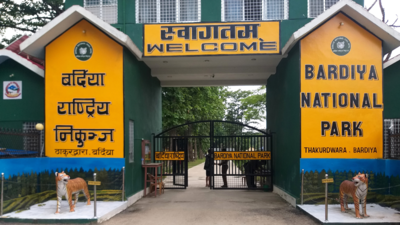[ad_1]

PILIBHIT: Wildlife consultants have prompt native communities in shut proximity to tiger reserves in Uttar Pradesh needs to be companions in wildlife conservation programmes to mitigate man-wildlife conflicts.
Mudit Gupta, WWF’s (World Large Fund for Nature), head of Terai Arc Panorama (TAL), which stretches 30,000 sqkm throughout Uttarakhand, Uttar Pradesh, and Bihar, introduced this view.After attending a three-day research tour of Bardiya Nationwide Park in Nepal, he mentioned, “As community-based wildlife programmes produced excellent leads to Nepal, they need to be adopted in UP with initiation at Pilibhit Tiger Reserve, which is going through man-tiger battle and large human infiltration in core forest areas.” TOI was an integral a part of the tour from the Indian facet.
Notably, forest and wildlife conservation and battle mitigation programmes in Nepal are enforced collectively by forest division, navy, native communities, and worldwide NGOs like WWF. The Nepalese navy has been tasked with making certain security and safety of forests and wildlife in protected areas.
In contrast to India, native communities in Nepal have been facilitated with separate ‘group forests’ for assembly important wants for firewood, grasses, fodder, medicinal vegetation, and looking of small animals.
The chief wildlife warden of Bardiya Nationwide Park, Ashok Ram, mentioned with the assistance of community-based wildlife programmes, the park achieved a threefold improve in variety of tigers from 20 to 60 in eight years with no man-tiger battle prior to now two years. “Human infiltration in core forests is nearly zero due to deployment of navy for cover of forests and wildlife,” he mentioned.
He added that victims of tiger assaults had been instantly offered monetary help of Rs 20,000 in case of minor accidents, Rs 50,000 to Rs 5 lakh if severely wounded, and Rs 10 lakh if killed. “Nepal has subsumed provisions of good-looking reparation in circumstances of home cattle killings in wildlife assaults and harm to standing crops by elephants by crop insurance coverage schemes. Insurance coverage premium is as little as Rs 1,000 for a coverage quantity of Rs 1 lakh of which 50% subsidy is offered by forest coordination committees of native communities,” he mentioned.
Ram added, “Bardia nationwide park, which stretches throughout 968 sqkm, has 125 tigers, 120 elephants, and 38 rhinos with uncommon prowling of any tiger in rural areas. This is because of plentiful prey base of 70,000 herbivores and virtually zero cultivation of sugarcane crops in proximity to protected forest areas, that are thought of hideouts for felines.”
Badai Tharu, vice-president of core administration physique of 38 forest coordination committees useful in Khata wild hall that connects Bardia nationwide park to Katarniaghat Wildlife Sanctuary of DTR, mentioned Nepalese govt supported committees with a revolving fund of Rs 9.5 crore to launch welfare and sustenance associated programmes for native communities.
“We offered two-way college buses for college students between properties and colleges for his or her safety from wild animal assaults. The forest coordination committees function many homestay services for eco-tourists and earn good-looking income for native communities. Locals assist wildlife conservation and battle mitigation programmes,” Tharu added.
Notably, native communities in proximity to tiger reserves in UP lack welfare and partnership programmes with forest division. There’s frequent unprecedented aggression of native farmers in circumstances of man-animal battle, large infiltration in core forests, unlawful felling of timber, and confrontation with area forest employees over assortment of forest produce.
[ad_2]
This Put up could include copywrite


